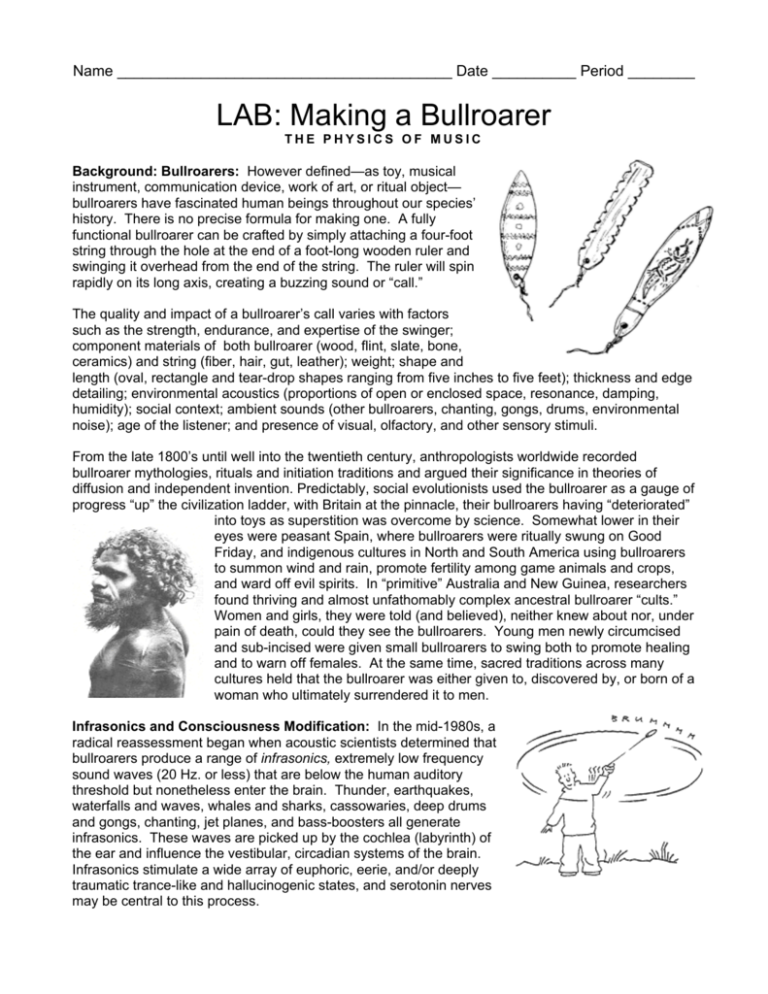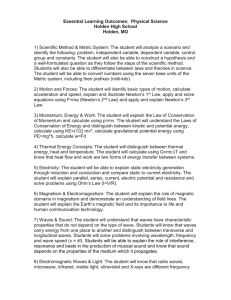LAB: Making a Bullroarer
advertisement

Name ________________________________________ Date __________ Period ________ LAB: Making a Bullroarer THE PHYSICS OF MUSIC Background: Bullroarers: However defined—as toy, musical instrument, communication device, work of art, or ritual object— bullroarers have fascinated human beings throughout our species’ history. There is no precise formula for making one. A fully functional bullroarer can be crafted by simply attaching a four-foot string through the hole at the end of a foot-long wooden ruler and swinging it overhead from the end of the string. The ruler will spin rapidly on its long axis, creating a buzzing sound or “call.” The quality and impact of a bullroarer’s call varies with factors such as the strength, endurance, and expertise of the swinger; component materials of both bullroarer (wood, flint, slate, bone, ceramics) and string (fiber, hair, gut, leather); weight; shape and length (oval, rectangle and tear-drop shapes ranging from five inches to five feet); thickness and edge detailing; environmental acoustics (proportions of open or enclosed space, resonance, damping, humidity); social context; ambient sounds (other bullroarers, chanting, gongs, drums, environmental noise); age of the listener; and presence of visual, olfactory, and other sensory stimuli. From the late 1800’s until well into the twentieth century, anthropologists worldwide recorded bullroarer mythologies, rituals and initiation traditions and argued their significance in theories of diffusion and independent invention. Predictably, social evolutionists used the bullroarer as a gauge of progress “up” the civilization ladder, with Britain at the pinnacle, their bullroarers having “deteriorated” into toys as superstition was overcome by science. Somewhat lower in their eyes were peasant Spain, where bullroarers were ritually swung on Good Friday, and indigenous cultures in North and South America using bullroarers to summon wind and rain, promote fertility among game animals and crops, and ward off evil spirits. In “primitive” Australia and New Guinea, researchers found thriving and almost unfathomably complex ancestral bullroarer “cults.” Women and girls, they were told (and believed), neither knew about nor, under pain of death, could they see the bullroarers. Young men newly circumcised and sub-incised were given small bullroarers to swing both to promote healing and to warn off females. At the same time, sacred traditions across many cultures held that the bullroarer was either given to, discovered by, or born of a woman who ultimately surrendered it to men. Infrasonics and Consciousness Modification: In the mid-1980s, a radical reassessment began when acoustic scientists determined that bullroarers produce a range of infrasonics, extremely low frequency sound waves (20 Hz. or less) that are below the human auditory threshold but nonetheless enter the brain. Thunder, earthquakes, waterfalls and waves, whales and sharks, cassowaries, deep drums and gongs, chanting, jet planes, and bass-boosters all generate infrasonics. These waves are picked up by the cochlea (labyrinth) of the ear and influence the vestibular, circadian systems of the brain. Infrasonics stimulate a wide array of euphoric, eerie, and/or deeply traumatic trance-like and hallucinogenic states, and serotonin nerves may be central to this process. Awareness of and experimentation with infrasonics in military applications, performance, rock art research, ritual, therapy, persuasion, and learning has grown exponentially with contemporary brain research. Infrasonics fall within the same frequency range as brain waves, and brain waves have been experimentally linked to a variety of mood and thought patterns. Theta brain waves (5 Hz - 8 Hz) are associated with creativity and insight; alpha waves (8 Hz – 13 Hz) with relaxed meditative states; and beta waves (13 Hz – 30 Hz) with fully awake, analytical thinking. The different parts of the brain simultaneously generate different waves, and researchers have only begun to imagine how environmental infrasonic mixes might actually shape or even have given birth to human consciousness. Traditional Symbolism: Bullroarers have been universally linked to spirit beings in the sky. In general, until the present proliferation of bullroarers for performance art and ritual, bullroarers worldwide were carved or painted in some way to acknowledge the strikingly brilliant constellation of Orion, thunder and lightning, the Milky Way, rhombs, the vesica piscis (“vessel of the fish”), and/or optical illusions (especially fine line grids which create virtual color). The oldest bullroarers are Paleolithic batons de commandement made of bone and incised with animals, lozenges (rhombic diamond shapes), zigzags, and astronomical references. A 6500-year-old bullroarer was found at Çatalhöyük in Anatolia (modern Turkey). Given the traditional practice of rubbing bullroarers with pigments, red ochre, oils and/or fats, it’s likely that 5400-year-old rhombic cosmetic palettes from Late Predynastic Egypt were swung. In classical Greek mythology, a rhombos (meaning bullroarer, but also rhomb, penis, and fish) was given as a toy to baby Dionysus just before his father Zeus had him killed by the Titans. Reborn from the thigh of his father, Dionysus lived on as god of fertility, vegetation, wine and ecstasy. Much like Orion, he is associated with death, rebirth and immortality. The name bullroarer is English and probably relates to Orion, who stands in the Milky Way just south of Taurus the Bull and is visible from every part of the globe. Orion derives from the Akkadian Uru-anna, “Light of Heaven.” Several researchers have noted (and then bracketed) the astonishing similarity between bullroarer cults in Australia and New Guinea and the Greek myth of the castration of Uranus (Ur-anus) by Gaia (which can be translated as “dung ball”) and her children. Many Australian bullroarers, which are almost exclusively long vesica-shaped ovals, carry names closely related to a word for excrement. Well into the twentieth century, the ceremonial ground on which youth initiations and circumcisions took place (and on which bullroarers were swung) was sometimes called “place of excrement.” Many interpreters believe the bullroarer represents a penis and that the sanctification of excrement relates to ritual homosexuality that occurs in some initiatory rites. There are other instances of two bullroarers ceremonially bound together and labeled “womb,” however. Fish-shaped bullroarers may relate to ancient traditions about spinning dolphins who assist humans. Recent iconographic research ties the dolphin (Greek delphys), the womb (delphis), and the lozenge shape (rhombos) to the constellation Delphinus the Dolphin (stars which form a rhomb on a string). The contemporary Dogon tribe of Mali in northwest Africa uses a fish-shaped bullroarer named po, which is also the name for their most important dietary seed grain (fonio) and the small dark companion star of Sirius (beneath the foot of Orion). Future Research Directions: History, anthropology, and the neurosciences are teaming up to decipher the roles of diffusion and independent invention in the remarkably uniform worldwide tradition of bullroarers. A major task is to understand the subtleties employed in generating the voice or “calls” of the bullroarer and their role in the creation of human belief systems—especially the spectrum of physical, emotional and hallucinogenic responses to beneficial (15 Hz. and above) and potentially “toxic” (below 10 Hz.) infrasonics. Of particular significance is the widespread belief that the bullroarer existed prior to deities or ancestor spirits. Robert L. Hall has argued persuasively that bullroarer and flint knife traditions can be analytically joined (Hall 1983, 75), thus providing an important window on the interpretation of historical artifacts such as the Aztec Sun Stone, whose tongue is a fish-shaped flint knife (Tecpatl) traditionally believed to have preceded the creation of the gods. (From Berkshire Encyclopedia of World History (2005) Bethe Hagens) Procedure: 1. Read the background information on bullroarers and answer the “Pre-Lab “questions (page 4) before returning to class. (You will not be able to participate in the lab unless you have answered these questions prior to the actual lab day) 2. Obtain a piece of wood (ask teacher) to construct your bullroarer. If you have brought your own wood to use, bring it up to the teacher to take a look at. 3. Utilize the template (attached sheet) to transfer the pattern to your bullroarer. Cut our along the dotted lines and lay the template over you piece of wood. Using a pencil, carefully draw the pattern on the wood. NOTE: If you would like to create a different design for your bullroarer, make a sketch and present it to the teacher for approval. 4. Bring your bullroarer to the teacher and he/she will help you cut out the rough shape. 5. Using rough (80 grit) sandpaper, carefully sand your bullroarer to make a nice smooth, symmetrical shape. Carefully round the edges (Ideally, you should produce a slight airfoil on each edge- like the wing of an airplane) 6. Once you bullroarer has been rough-sanded, obtain some finer sandpaper and give your bullroarer a final sanding (you might start with 120 grit and finish with some 240 grit sandpaper) 7. When you have finished sanding your bullroarer, bring it to the teacher and he/she will help you drill a hole to attach the cord. 8. Now you will need to design the decorations for your bullroarer. Utilizing books, or the Internet, find an authentic design from one of the cultures that used bullroarers and create the design in the space provided (page 3). You must create a design on paper prior to decorating your actual bullroarer. You must also answer the questions about the design you chose. 9. After you show the teacher your proposed decoration, you are now ready to decorate your bullroarer. Utilize permanent markers, paint, or any other materials you would like to do your artwork. When you are completed with this, bring your decorated bullroarer to the teacher and they will help you give a final coat of lacquer to finish off your design. 10. Once the lacquer has dried, cut a 4 meter long piece of nylon cord. Push one end of the cord through the hole and pull it through so that the cord in now doubled (it should be roughly 2 meters long now). 11. Once you have done this, tie an overhand knot, leaving about 1 inch between the bullroarer and the knot (look at the example on teacher’s Overhand knot desk). 12. Continue tying overhand knots down the length of the cord about every 6 to 12 inches. Tie a final overhand knot at the end of the cord. (Look at the example on teacher’s desk). 13. You are now ready to try out your bullroarer. CAUTION: Do not swing your bullroarer in the classroom or around campus. Always use extreme caution when swinging your bullroarer. After going outdoors with the class, space yourselves about 20 feet apart and wait until the teacher gives you the OK to begin. Swing the bullroarer like a lasso around your head. You should begin to hear a “buzzing” sound as it begins to rotate rapidly on its long axis as it swings in a circle. As it spins it will wind up the cord until the tension builds up, causing it to rotate in the opposite direction. When you have finished testing your bullroarer, answer the conclusion questions. Pay particular attention to the differences in sound produced by different shapes and sizes of bullroarers, as well as the speed at which you whirl the bullroarer around your head. (You may want to pre-read the conclusion questions before we test our bullroarers) Pre-lab Questions (answer after reading the background information) 1. What is are some of the factors (variables) that influence the sound (the bullroarer’s “call”)? 2. Name at least 4 places (cultures) around the world that the bullroarer has been used throughout history. 3. What is an infrasonic sound? (What is the frequency of sound waves that are considered infrasonic?) 4. What infrasonic frequencies are considered to be beneficial? Toxic? 5. What type of physiological effects are these infrasonic sound waves thought to produce? 6. What are the oldest known bullroarers that have been discovered? 7. What do you think produces the sound waves created by swinging the bullroarer overhead? (Use physics terms to explain) 8. What do you think is meant by diffusion and/or independent invention of the bullroarer around the world? Conclusion Questions: 1. Draw you preliminary bullroarer design on the template to the left. 2. Which culture did you choose and what is the significance of your artwork? 3. When you were swinging your bullroarer you may have noticed that at times it began to move upwards, while at others it seemed to move downwards. What do you think caused this? (HINT: think of an airplane’s wing. You may have to look in your textbook or the Internet to answer this one) 4. Which type (size, shape, mass) of bullroarer created the lowest frequency sound? The highest frequency? 5. How did the speed at which you whirled the bullroarer effect the frequency of sound waves produced? (remember that sound travels at a uniform speed of about 340 m/s at sea level) Explain using physics terms. Remember also that: v=λ⋅ f 6. How did the difference in mass of the bullroarer’s effect the sound that was produced? 7. Explain how the sound waves were generated by the bullroarer. You must use the following terms in your explanation: frequency (pitch), loudness (amplitude), wavelength, velocity, vibration, mechanical wave, longitudinal wave, compression and rarefaction. (Your answer must be a minimum of 200 words)







